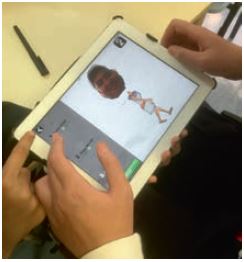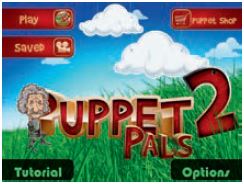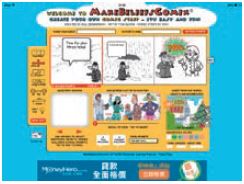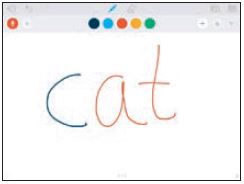iPads. Learning tools or toys?
We can often be a little apprehensive about using tablet computers or iPads with young EFL learners. We fear that the classroom will soon descend into chaos and mayhem. We know that our students will be jumping for joy at the sight of them. However, we think they will take up a lot of valuable class time, are expensive to purchase and students may gain little from their use in the classroom. It is true, young learners are very excited by the sight of iPads. For them, an iPad is a toy that they can play games on, such as, Candy Crush and Angry Birds. It is important for us to make them aware that it can be used as a learning tool and not just a toy. This means we need to have a good idea of how we are going to use iPads in our lessons, as well as ensure we plan their use carefully. Then our learners will be highly motivated and actively engaged in learning with technology.
In this short article, I will suggest some rules and routines for successful use of iPads and tablets in the class with young EFL learners. I will then introduce some great apps I have used with learners.

Rules
iPads bring a new dimension into the classroom. Students might be very familiar with them at home, but at school they need to be seen a little differently. Students need to be aware that they must value them. Teaching students some simple rules, or developing the rules together, is a way to ensure harmonious use of iPads in your lessons.
These are some rules developed by a previous colleague of mine and they work well. Students know their expectations and are very willing to follow them when they can use an iPad.
- Carry the iPad with two hands.
- Keep the iPad on the table.
- Share with your classmate and stop when your turn is over.
- Turn off the iPad when the teacher is talking.
- Only use the app or website the teacher has asked you to use (the name of the selected app can be written on the board or the logo can be displayed on a chart).
Routines
Students can be better at using iPads than we are, but they tend to learn by experimentation, clicking on every button and seeing what happens. This approach is fine at home but may mean they do not get to use the app as you intended. Spending time at the beginning of the session, introducing the app to the class is beneficial and ensures they know what to do. This is strengthened when you inform them why you will use the app with them and what skills they will be developing. If you only have a few iPads and not everyone is going to use them, it is a great idea to make a timetable so students know when their iPad time is and how long they get to use it for.
The first few times I use iPads or tablets with a class, I like to stick to these routines.
- Introduce the app or website and how to get to it. Remind students of the rules and the chart showing the app they can use – What app will we use?
- Tell the learners the objective of using the app – Why do we use the app?
- Model how to use the app or website – How can we use it?
- Observe students using the iPads and give support.
- Wrap up the lesson and discuss what they learned or produced and whether the iPad enhanced the learning experience.
Apps with young learners
Okay, now I’ve discussed the rules and routines. Here is the fun bit: a few apps I have used that have been great with young EFL learners in the classroom. There are a large number of apps available that are specifically designed to help learners develop their English skills. However, most focus on isolated skills such as vocabulary and grammar. I like to use apps that bring all the students’ learning together and let them produce something meaningful. There are three apps I have used that help me do that: Puppet Pals 2, Make Beliefs Comix, and Educreations Interactive Whiteboard.
Puppet Pals 2

This is my favourite app for use in the EFL classroom with young learners. On Puppet Pals 2, students can select a stage and character and create an interactive puppet show. The show can be saved and played back for the whole class or posted online on the class blog. There are a lot of scenes (e.g. the Wild West, underwater or outer space) and characters (e.g. police officers, ballerinas, cowboys or Shakespeare) to choose from. Students can even add themselves into the show by using the built-in camera. The students can then act out the scene live and play it back.
I have used this app in writing lessons. Students work together to write a short story using the scenes and characters available on Puppet Pals 2. They then turn their story into a short show using the app. It is a great way to highlight the importance of dialogue in story writing. It has the added bonus of getting reluctant speakers to talk.
There is a free version available as well as a paid version with more features and characters. I recommend you try the free version first and see if the app is useful for you and your learners.
Make Beliefs Comix

This app is another great one for your classroom. It is a fun and engaging way to design comic strips. Student can select from a large number of characters and scenes to create 2-, 3- or 4-panel comic stories. They can add captions and speech bubbles. The characters and graphics are visually appealing for young learners and the functions are user friendly and easy to learn.
I have used this app in reading and writing lessons. After reading a story, you can get your learners to make a comic strip to summarise the story, or think and create an alternative ending to the story to share with their classmates. In writing lessons, the app can be used to create illustrations for students’ stories and storyboard their ideas. It helps develop students’ creativity and even those that do not like to draw can create something visually appealing. The speech bubble function can help learners practise writing dialogue.
Currently this app is free and there is also a web-based version available here.
Educreations Interactive Whiteboard

Educreations Interactive Whiteboard looks like a normal whiteboard or drawing app. However, it has a number of additional features that make it a great resource for the young EFL classroom. You can animate and narrate as you write on the iPad. Students or teachers can create short video clips and share them with their classmates. The app can be used to record the students’ voices, drawings and handwriting. Pictures and photos can be added.
This is a great app for use in phonics lessons. Students can make short little ‘How to’ videos teaching different skills or strategies, such as onset and rimes, to their classmates and then share them. It can be used for making other instructional or information videos, such as how to make origami or introduce students’ favourite food or places.
Currently this app is free but with limited functions. A ‘Pro’ version is available and that requires a monthly subscription.
Conclusion
It can be scary to bring iPads into your classroom with young learners. However, if the rules and routines are in place and the lesson objectives are well planned, then they can be great tools for enhancing the English language learning experience. Students will be highly motivated and fully engaged and might even teach you a thing or two! If your school only has a few iPads, don’t worry, most of the apps I have suggested work great with small groups of learners.
Benjamin Luke Moorhouse is a lecturer in the Faculty of Education at the University of Hong Kong. He has more than seven years experience teaching EFL at the primary level in Hong Kong and spent a year working for the Education Bureau there. His research interests include L2 homework, L2 literacy and critical pedagogy.

Comments
Write a Comment
Comment Submitted